Let’s be clear: the post-Article 370 Kashmir is not “normal” by any stretch of the imagination. But has Kashmir ever been normal since 1989? After three phases of disruptions in the Valley – in 2010, 2014 and 2016 – Kashmiris have fine-tuned the art of coping, and learned ways to turn the abnormal circumstances into the new normal of their lives. These coping mechanisms can be seen across a whole range of essential services – from food and medicine to schools and shops.
Stocking food
The general sense in Soura, Srinagar, was that the shutdown of shops would continue indefinitely. On how people would manage, the answers ranged from “hamare paas poore saal ke liye kaafi hai (we have enough for a year)” to “abhi teen mahiney ke liye hai, uske baad raaste pe aake marenge aur kya (the stock will last three months, after that we will be dying on the streets)”. I learnt quickly that the Kashmiris are natural hoarders, stocking up for long, cold winters. Every house that I visited in the Valley had, without exception, several large sacks of rice and dried vegetables like pumpkin, brinjal (and a few others that I couldn’t make out).
Similarly, the street cart vendors, be it the ubiquitous fish and mutton kebab vendors or the vegetable sellers, were doing their business as usual. Most importantly, one could see fresh bananas and oranges, which do not grow in the Valley. This means that they are being brought in fresh from elsewhere. Clearly, whatever the Kashmiris are worried about, food isn’t one of them.
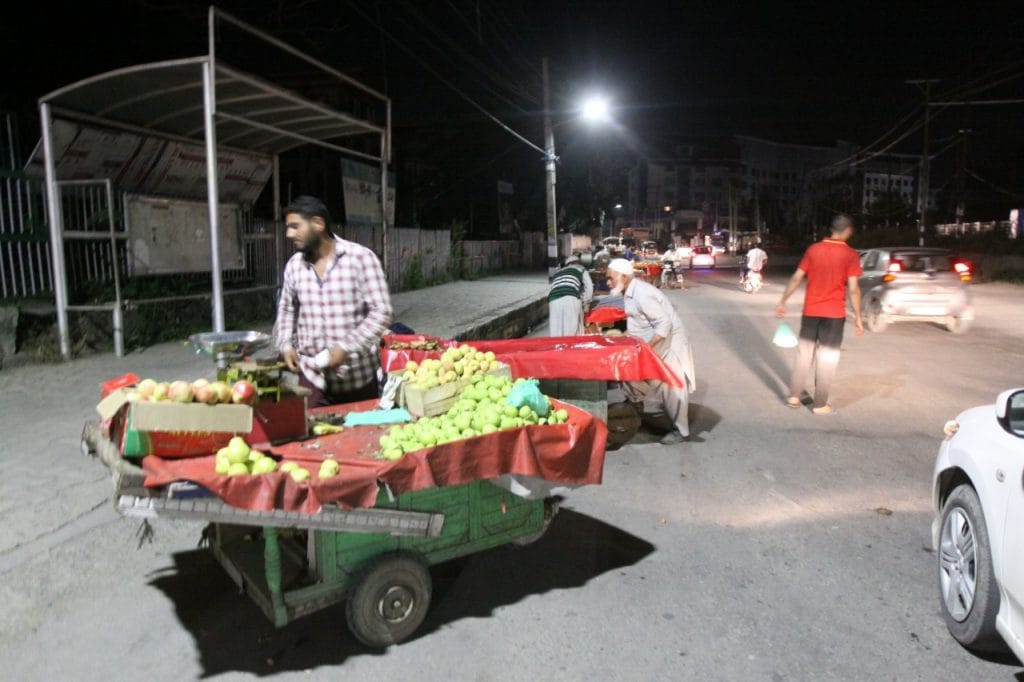
Also read: BBC & Al Jazeera footage of Soura clashes were from security cameras, and Modi govt knew
Schools run with parents’ help
Schools too are coping. They remain open, except none of the schools allow entry from the front gate that opens onto the main road. Once inside, you find teachers present in full strength – every staff room I visited had teachers sipping cups of tea – but the students are almost entirely absent. The 20 to 40-odd students that I saw in every school were not in their uniforms.
From my interviews with several principals, I learnt about the measures schools in Kashmir have undertaken to overcome the shutdown. Borrowing from the lessons learnt in 2010 and 2014, and perfected in 2016, schools have come up with detailed study modules for the students. Parents are required to submit their children’s work every fortnight and bring USB drives to collect new assignments. None of this is done secretly – schools publish advertisements in local newspapers asking parents to submit and collect assignments.
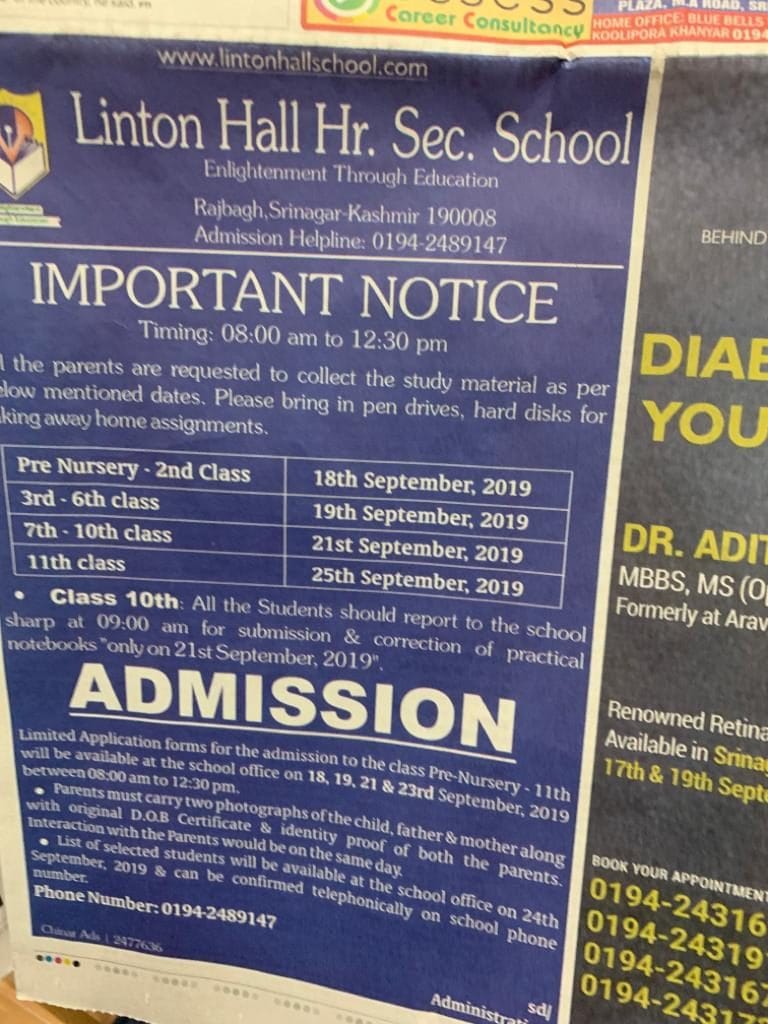
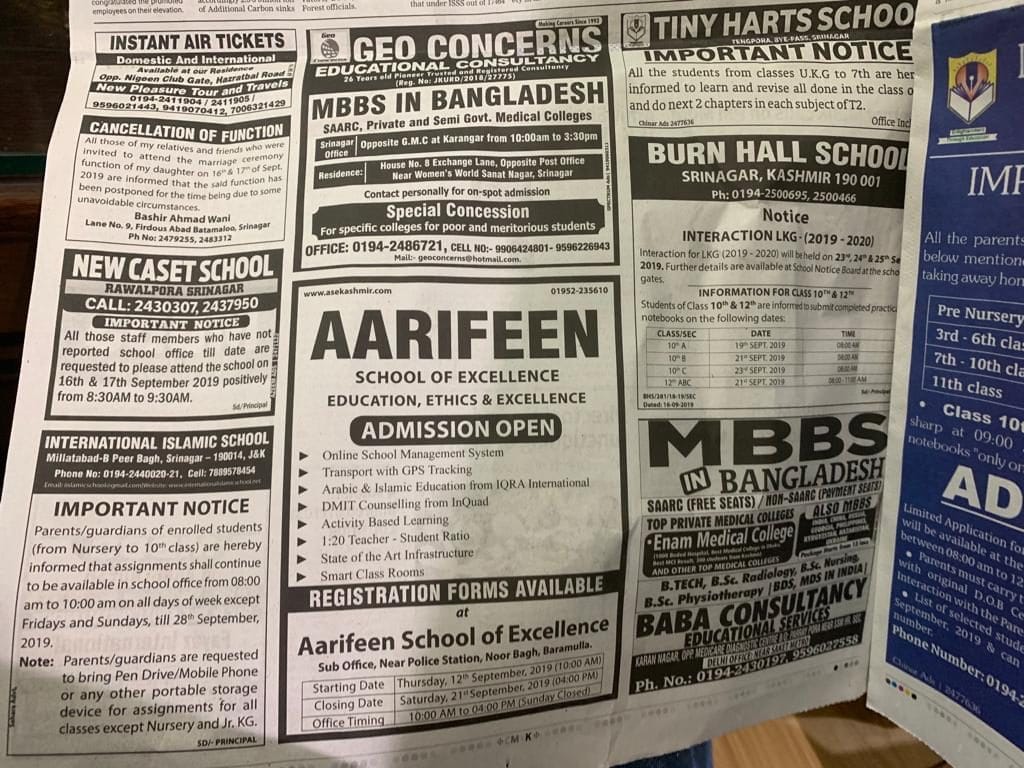
Significantly, this also busts the myth that newspapers in Kashmir aren’t being published. These communication ads for parents, and those offering MBBS degrees in Bangladesh, are the main source of revenue for the newspapers.
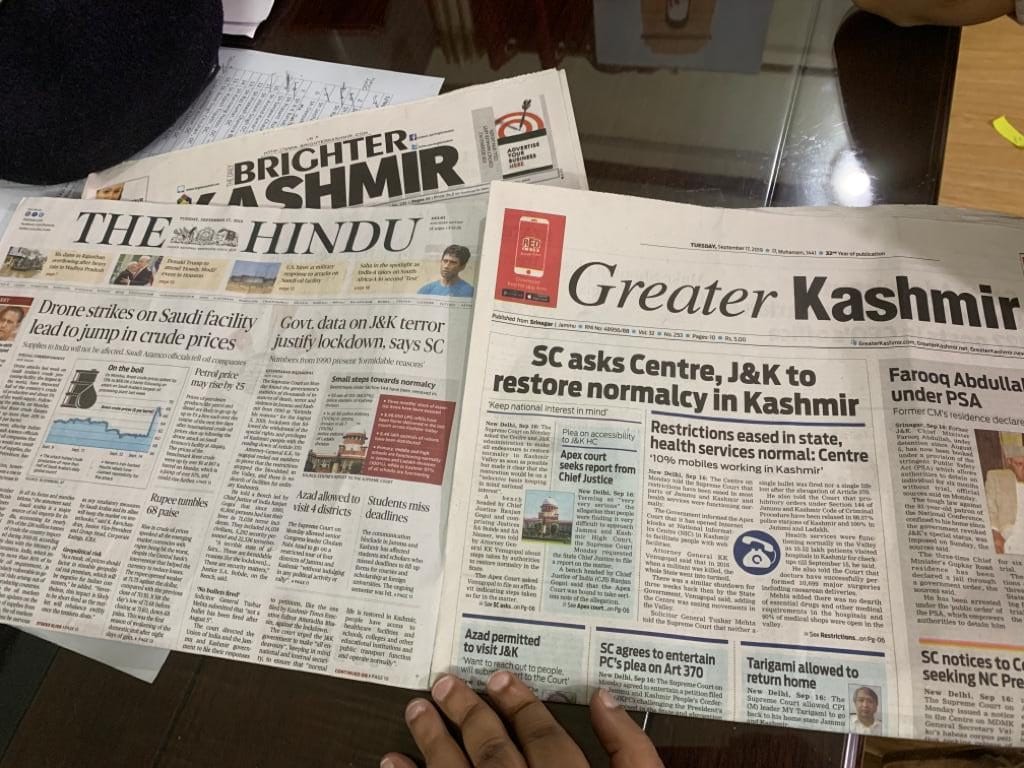
However, the few students who do turn up for classes aren’t very happy with the way things are. They complained that even though the materials provided to them were quite detailed, they weren’t a substitute to the interactive, didactic sessions they have with the teachers to clarify their doubts. The teachers, for their part, admit that parents have to chip in, but are quick to add that there was no discernible drop in the quality of submitted assignments.
The situation in Kashmir, both in the past and at the moment, has had a corrosive influence on the education system. The state government comes up with measures like mass promoting students of state board without conducting the annual examination, as was done following the unrest in 2016 for classes V to IX and class XI. Students who aren’t automatically promoted are given the option of taking the exam either at the end of the shutdown or six months later. Both scenarios are problematic. While the former ignores merit by promoting everyone, the latter essentially forces students weak in studies to prolong their education, cutting their chances of getting timely admission in college.
Also read: After scrapping of Article 370, Shias in Kashmir are in a state of relief and caution
Defiant shopkeepers devising ways
The situation with the shops in Kashmir is the most difficult to assess, as it varies from district to district. As mentioned before, street cart vendors have never had it better. However, a major coping mechanism to deal with the ongoing scenario was witnessed in Srinagar. The Sunday market erected on one side of the Polo Ground now remains in place throughout the week, selling everything from household goods to clothes. Meanwhile, people with permanent shops said they have to shut the shops every now and then “because of the curfew”. “Every evening, police officers come in vans and ask us to shut down our shops.” However, not one shopkeeper was able to produce video recording of police vans coming to the market with officers shouting orders to down shutters.
The day I arrived in Srinagar, I noticed the shops were open until 10 am and then again from 6 pm to 8 pm. However, in the space of seven days, the duration had increased — until 11-11.30 am and again from 4 pm to 9 pm. Then there are ways like taking turns. Three-four shops open as others in the vicinity remain shut; after an hour, these shops down their shutters and those that were shut spring to life. Some shopkeepers kept their shops open throughout, although with the shutters pulled half way or three quarters down.
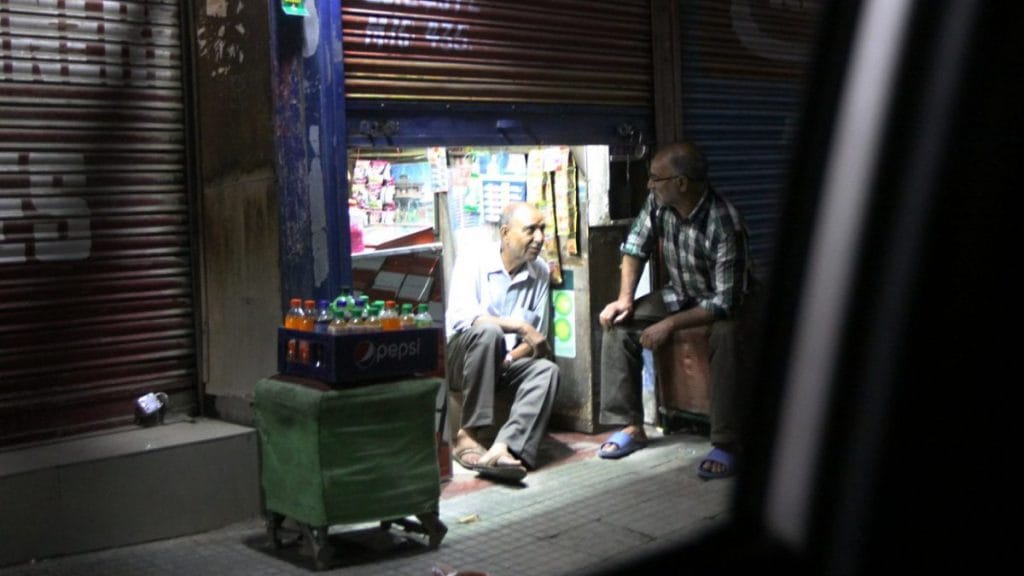
In Srinagar’s Residency Road, about 80 per cent of the shops opened at some point during the day, and stayed open for four to eight hours. Speaking to the shopkeepers over several days, it became clear that at least in Srinagar, the fear wasn’t from the militants but from the “goons” of PDP and NC who allegedly threaten the shop owners. However, shops that did stay open throughout were all within 10-15 meters of CRPF and Jammu and Kashmir Police pickets.
The situation in Budgam is entirely different. Here, Aga Hassan, a spiritual leader of the Shias, has called for shops to be shut in protest over his house arrest. But supporters of a political challenger, Imran Reza Ansari, the president of All Jammu and Kashmir Shia Association, keep their shops open just to spite the followers of Aga Hassan. In Sunni-dominated rural Budgam, the Sunnis make it a point to open their shops (which are few in numbers and most of them are provision stores) also to just spite the Shia leader.
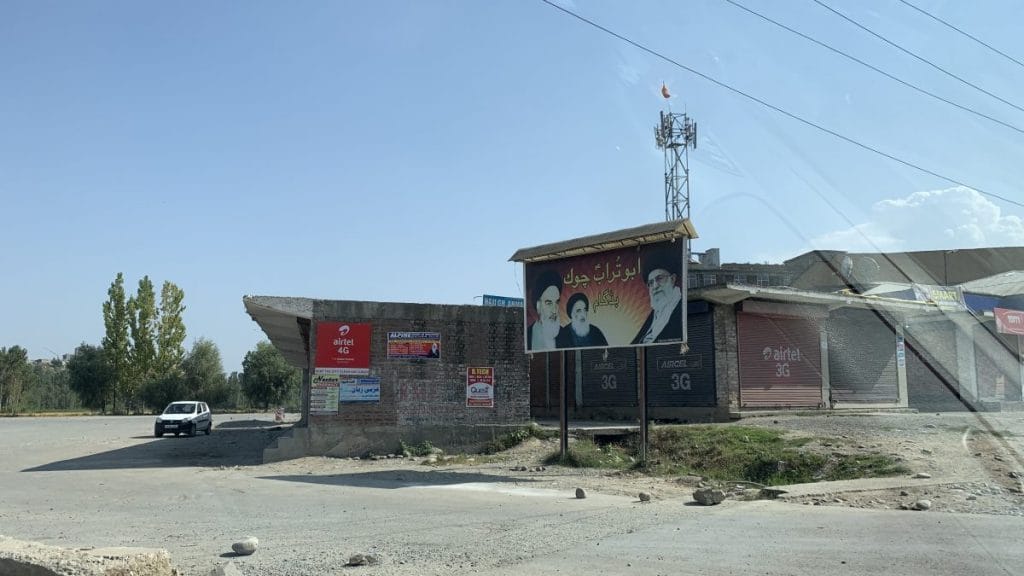
Shopian and Pulwama are again totally different and were the only place in the Valley where the shutdown seemed absolute, except for bakeries. Looks, however, can be deceptive. As some kids explained to me, “Hum to sab ek doosre ko jaante hain, jab kuch chahiye, unke ghar jaake poochte hain (people here know each other and if they need anything, they go to the shopkeepers’ homes)”. In short, you can’t just take a “stroll” in the market, although if you want something specific, you will get it.
Clearly then, things are not optimal, but they’re definitely not as bleak as some make it out to be. Kashmiris are resilient and have honed coping mechanisms over the years. Shopkeepers in particular seem to be challenging the shutdown, with each opened shutter an act of defiance to the local strongman’s diktats. The best way to describe it is perhaps to bastardise Charles Dickens’ opening lines from the immortal A Tale of Two Cities: “it wasn’t the best of times, but it wasn’t the worst of times.”
The author is a senior fellow at the Institute of Peace and Conflict Studies. He tweets @iyervval. Views are personal.
This is the fourth part of a series by the author based on his recent Kashmir visit. Read the first part here, second here and third here.



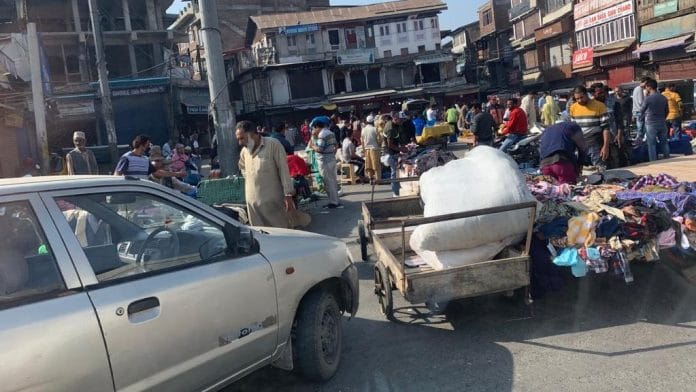



Just like demonitasation which was entirely oppressive and avoidable this abrogation was avoidable. All security measures to avoid stone throwing and elections could have been explored without abrogation.
A similar situation under Nazi occupation in Poland, and in Baghdad immediately after the USA invasion. Calcutta 1942 after Gandhiji’s call for a hartal againt the British.
This is active resistance by a civil population against an oppressor. This is rapidly getting beyond the civil disobedience stage, they will be soon a network Of resistance like the French resistance.
Fascism will be defeated, you cannot crash the people and deprive them of their freedoms, the people’s struggle always wins.
If people are threatened, people won’t take any risk. It is not Kashmir specific. No one wants to be killed or harmed by anyone. However, that the so called curfew is imposed by terrorists/jihadists and other goons, must be let known to all.
This article shows that things are not normal in J&K. Somehow people are pulling on with their lives based on their past experience of disturbances in the state. Wonder when the normal life would start in the state.
One does not understand why the people are being put through so much hardship and economic loss. We have never been wildly popular in the Valley, all the more since 1989. These developments can only widen the gulf. If the intention is to crush their spirit completely, one cannot argue with that proposition.
I always look for Ashok’s. Comments
There Perl’s of wisdom, he should be writing these articles
Not some Print magazine hack
AShok is always the Democrat he is very fair
He should’ve been the member of the government, many of India’s problems would’ve been solved if he had been in charge.